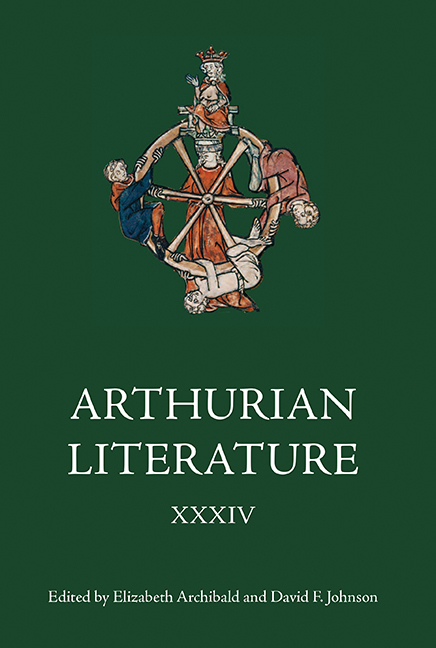Book contents
- Frontmatter
- Contents
- List of Illustrations
- General Editors’ Foreword
- List of Contributors
- I Illusory Ends in Chrétien de Troyes’ Erec et Enide
- II Who is the Traitor at the Beginning of Sir Gawain and the Green Knight?
- III Sir Gawain's Death and Prophecy in Malory's Morte Darthur
- IV Late Medieval Irish Kingship, Egerton 1782, and the Irish Arthurian Romance Eachtra an Mhadra Mhaoil (‘The Story of the Crop-Eared Dog’)
- V ‘Which I have beholden with most curiouse eyes’: The Lead Cross from Glastonbury abbey
- VI The Arundel Coronatio Arthuri: A Middle English Sword in the Stone Story from London, College of Arms MS Arundel 58
- Arundel Coronacio Arthuri
- Appendix I Linguistic Profile For Aca
- Appendix II Select Glossary
- Contents of Previous Volumes
I - Illusory Ends in Chrétien de Troyes’ Erec et Enide
Published online by Cambridge University Press: 17 July 2019
- Frontmatter
- Contents
- List of Illustrations
- General Editors’ Foreword
- List of Contributors
- I Illusory Ends in Chrétien de Troyes’ Erec et Enide
- II Who is the Traitor at the Beginning of Sir Gawain and the Green Knight?
- III Sir Gawain's Death and Prophecy in Malory's Morte Darthur
- IV Late Medieval Irish Kingship, Egerton 1782, and the Irish Arthurian Romance Eachtra an Mhadra Mhaoil (‘The Story of the Crop-Eared Dog’)
- V ‘Which I have beholden with most curiouse eyes’: The Lead Cross from Glastonbury abbey
- VI The Arundel Coronatio Arthuri: A Middle English Sword in the Stone Story from London, College of Arms MS Arundel 58
- Arundel Coronacio Arthuri
- Appendix I Linguistic Profile For Aca
- Appendix II Select Glossary
- Contents of Previous Volumes
Summary
There have been countless attempts to theorise une mout bele conjointure, the formulation used by Chrétien de Troyes to describe his compositional technique in the prologue to Erec et Enide. Yet the term bele conjointure perhaps more accurately defines the ideal result of this distinctively medieval poetic practice: that is, an elegant sequence consisting of skilfully conjoined but diverse elements. Whatever the exact significations of this phrase – and it has long been an issue of contention for Chrétien scholars from Wendelin Foerster and W. A. Nitze to Eugène Vinaver and Douglas Kelly – most agree that it describes the construction of a pleasing and composite cortex that includes even the smallest units of poetry, an intricate surface that conceals a nucleus of truth beneath it. Those readers familiar with the prescriptions of medieval treatises on poetic composition, such as those of Geoffrey of Vinsauf and Matthew of Vendôme, will recall that the end of a medieval poem is vital in establishing its significance, in making it whole, complete and meaningful, and might therefore expect to find this nucleus in the concluding portion of the romance. It is curious then that Chrétien, so accustomed to directing his readers as to the origins of his compositions in the prologues and preambles to his romances, does not once comment on his approach to the construction of endings and their significance. In the absence of such direction, it is important to scrutinise the endings of Chrétien de Troyes’ romances to understand how he brought his literary compositions to closure, and to ascertain whether they do in fact contain a nucleus of poetic truth or not. As the first of Chrétien's romances, and the origin of bele conjointure, Erec et Enide seems a sensible place to begin.
In the closing verses of Erec et Enide, the ‘chevalier plus loé’ (line 85) and ‘la plus bele’ (line 297) are formally reconciled with one another and with the ‘mainte diverse contree’ of the Arthurian world (line 6644), crowned in a great crescendo of harmony, optimism and beauty:
Li ceptres fu au roi bailliez, ad
Qui a mervoilles l'esgarda;
Si le mist, que plus ne tarda,
Li roi Erec an sa main destre; ad
Or fu il rois si con dut ester. ad
Puis ra Enide coronee.
- Type
- Chapter
- Information
- Arthurian Literature , pp. 1 - 21Publisher: Boydell & BrewerPrint publication year: 2018



